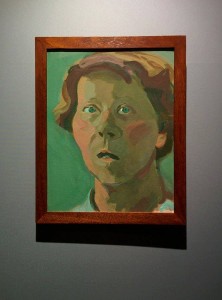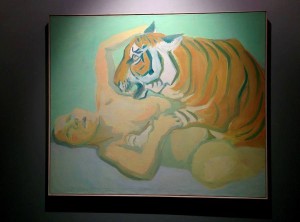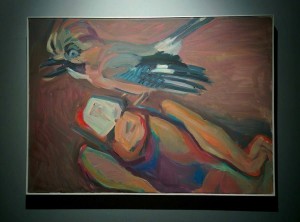Maria Lassnig Woman Power
Palazzo Pitti, 25 marzo – 25 giugno 2017
Di Caterina Zaru (Università degli Studi di Firenze)
La prima mostra, che si sia mai organizzata in Italia, dedicata interamente all’artista austriaca, scomparsa nel 2014 all’età di 94 anni, trova spazio nelle sale dell’Andito degli Angioini a Palazzo Pitti e sarà visitabile fino al 25 giugno. Una piccola esposizione realizzata in collaborazione con l’Albertina di Vienna, che si fa conservatrice del nucleo più importante delle opere di Maria Lassnig, e curata da Wolfgang Drechsler. Lo stesso Drechsler ha curato anche il catalogo, edito da Sillabe.
Fu proprio in Italia, alla Biennale di Venezia del 2013, che Maria Lassnig ricevette il Leone alla carriera. E ora Firenze rende omaggio a questa artista, pioniera del movimento femminista nelle arti visive, esponendo venticinque opere, attraverso cui ripercorrere la sua singolare produzione pittorica. Singolare perché, a detta dello stesso curatore della mostra, l’arte della Lassnig trova il proprio centro in un’autoreferenza dell’artista che si autoritrae di continuo, anche quando, in realtà i titoli delle opere ci dicono tutt’altro. Ma importante, non è tanto la fisionomia dell’artista, quanto le sensazioni che, dal profondo di sé, sprigionano sulla tela, in poche, potenti pennellate di abbaglianti colori. La sensazione visiva provocata nello spettatore si fa specchio delle forti sensazioni fisiche e corporee espresse dall’artista ed indagate attraverso i dipinti esposti come Doppio ritratto con aragosta, 1979 o A letto con una tigre, 1975 e ancora Uomo che si taglia in due del 1986, Pescatori di idee del 2001 e Il dolore del 2003. Una “consapevolezza corporea”, una messa in gioco della propria sensibilità, sotto forma di un linguaggio artistico suggestivo ed estremamente comunicativo.
Un’artista che mette al centro della propria sperimentazione se stessa e il proprio corpo, ma senza cadere nel narcisismo o nell’autocelebrazione.
Una donna che si fa fautrice dell’emancipazione femminile, dando vita ad opere come Woman Power, che non a caso dà il titolo all’intera mostra, in un ambiente artistico dominato dagli uomini. E, ancora, non a caso, si è deciso di porre proprio quest’opera in una posizione privilegiata del percorso espositivo: lo spettatore se la ritroverà di fronte, con tutta la sua potenza espressiva, non appena varcherà la soglia della seconda sala. Sala che accoglie anche l’altro cavallo di battaglia dell’esposizione: A letto con una tigre.
Parlando, appunto, del percorso espositivo, si può ben affermare che la location, l’Andito degli Angioni, crea quell’affascinante contrasto tra antico e moderno, che dà grande risalto alle opere della Lassnig. Le pareti, solo in alcuni casi ricoperte da pannelli grigi, ed i soffitti affrescati delle sei sale dedicate alla mostra, costituiscono un’elegante cornice alle opere esposte. Uniche note negative l’apparato didascalico, povero in pannelli esplicativi (gli unici due sono posti nell’ultima sala, a conclusione del percorso espositivo), e l’illuminazione. Questa risulta essere molto efficace nell’illuminare le opere e nel dare risalto ai colori, d’altro canto, però, l’atmosfera che ne risulta è molto cupa. Questo aspetto, purtroppo, non invoglia il visitatore a soffermarsi a lungo negli ambienti e a godere al meglio delle opere esposte.
Nel complesso, comunque, questa mostra risulta essere un’interessante iniziativa che prende in esame un argomento delicato, quale il conflitto di genere in ambito artistico, e lo espone rendendo omaggio al mondo artistico femminile, che trova nella Lassnig una forte protagonista dell’epoca contemporanea.
Translated by: Rachyl Grussing (Istituto Lorenzo de’ Medici)
This show, one of the first of its kind which has been organized in Italy, is entirely dedicated to the Austrian artist Maria Lassnig, who disappeared in 2014 at the age of 94, and it finds space in the rooms of Anguilla Angels at the Pitti Palace and will be open until the 25th of June. It is a small show which has been realized in collaboration with The Albertina of Vienna, which preserves the most important core works of Maria Lassnig, and is curated by Wolfgang Drechsler. The same Drechsler has also curated the catalogue, edited by Sillabe. It was in Italy, at the Venice Biennale in 2013, that Maria Lassnig received the Lion of his career. Now, Florence pays homage to this artist, who pioneered the feminist movement in the visual arts, displaying 25 works, through which we can rethink the singular production of his paintings. Singular because, according to the same curator of the show, the art of Lassnig finds it center in the self-referral of the author who is constantly authoritative, and when, in reality the titles of the works tell us nothing else. But important, not so much the artist appearance, as much as the profound sensations that spring up from the depths of the canvas, in a few, powerful, dazzling strokes of color. The visual sensations provoked in the viewer mirror the strong physical and corporeal sensations of the artist and that are investigated through works like Double Portrait with Lobster, 1979, and A Bed With a Tiger, 1975, and also Man That Cuts in Two from 1986, Fisherman of Ideas from 2001, Pain, 2003. A ‘bodily awareness’, a putting into play of their own sensibilities, in the form of a suggestive and artistic language.
An artist that puts herself and her body at the center of the experimentation, but without falling into narcissism or self-celebration.
A woman that is an advocate for the emancipation of the feminine, giving life to works like Woman Power, which is by no means the title of the whole show, in an environment that is dominated by men. And, yet, not by chance is the decision to place this work in a privileged position within the exhibition path: the visitor will face it, with all its potent expression, as soon as he will cross into the second room. This room also welcomes the other battle of the exhibition, A Bed with A Tiger.
Speaking just to the path of the exhibition, it can be said that the location, the corridor of the Angels, creates a fascinating contrast between ancient and modern, that gives grand prominence to the work of Lassnig. The walls, only in some cases covered in gray panels, and the frescoed ceilings of the six rooms dedicated to the exhibition, constitute an elegant frame to the show. The only negative notes are the didactic apparatuses; poor explanatory panels (the only two are located in the last room, the conclusion of the exhibition), and the lighting. This results in effective illumination of the works and highlights the colors, however, on the other hand, the resulting atmosphere is very dense. This aspect, unfortunately, does not invite the visitor to dwell in the space for very long and enjoy the best works on display.
Overall, however, this exhibition is an interesting initiative that examines a delicate argument, such as the conflict of gender in the artistic environment, and it exhibits this by paying homage to the feminine world, which finds in Lassnig a strong protagonist in the contemporary age.


